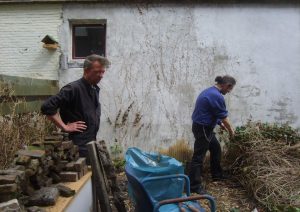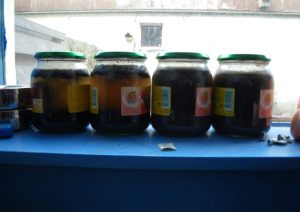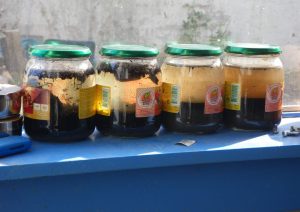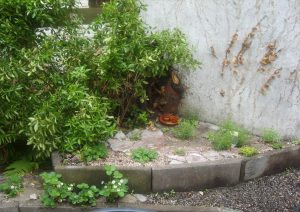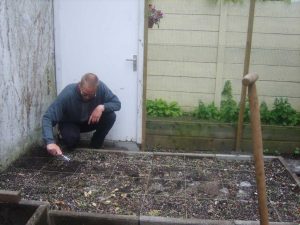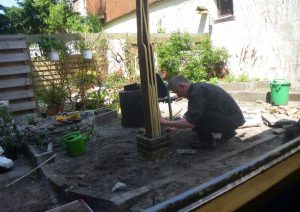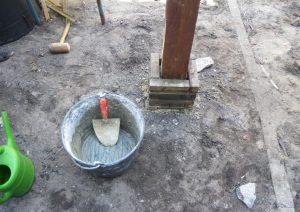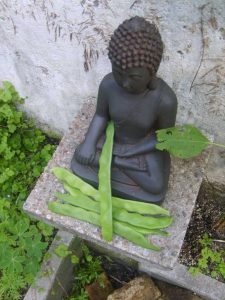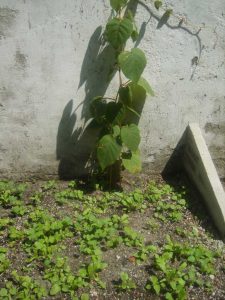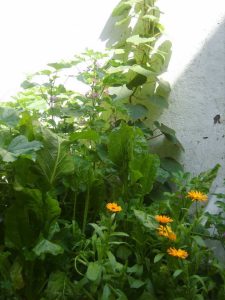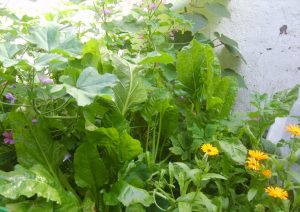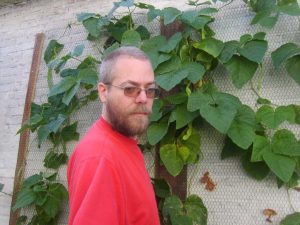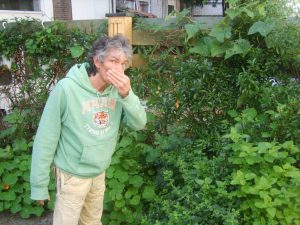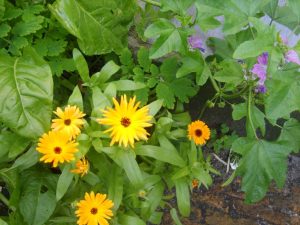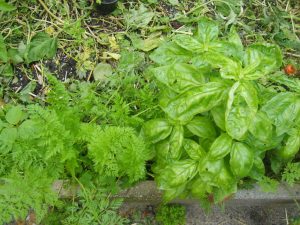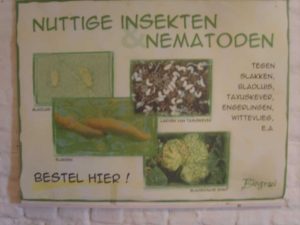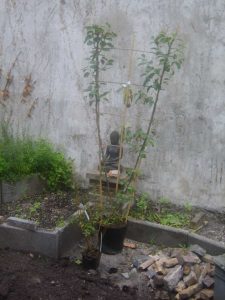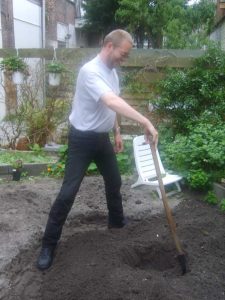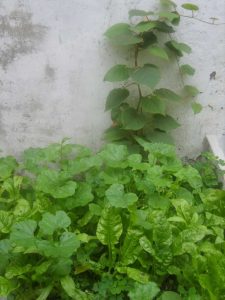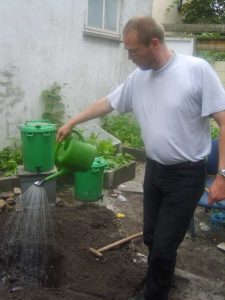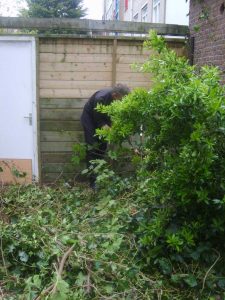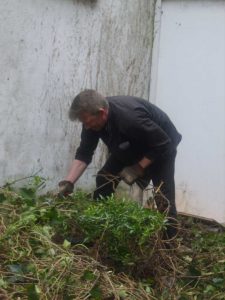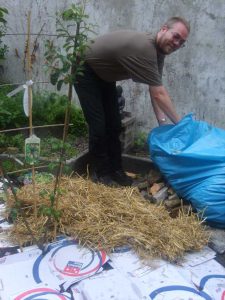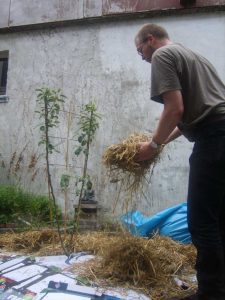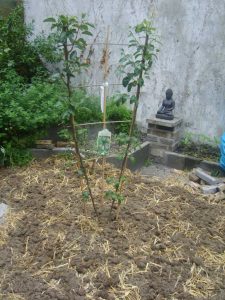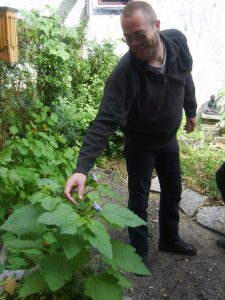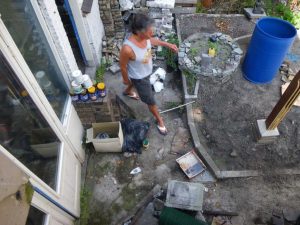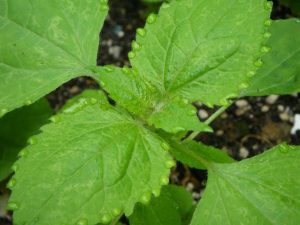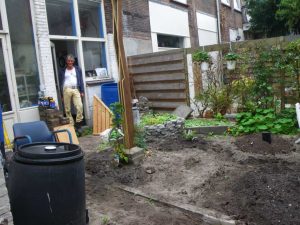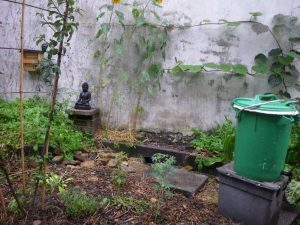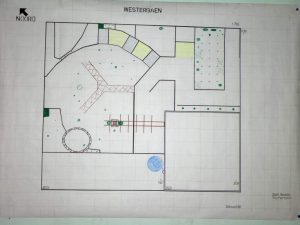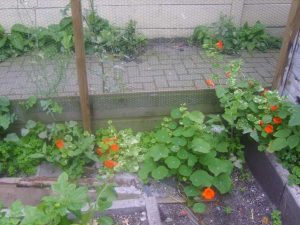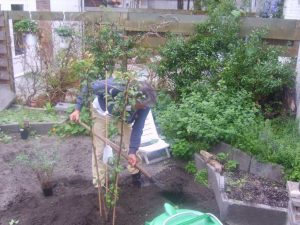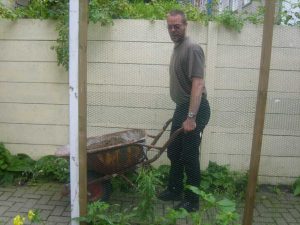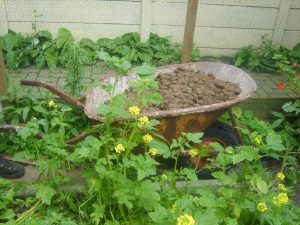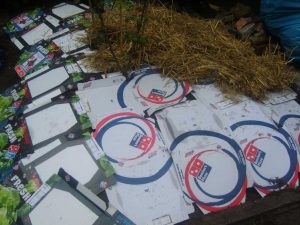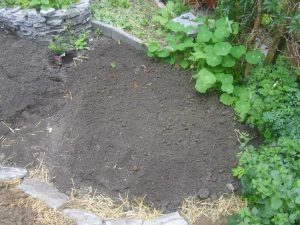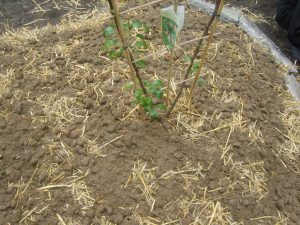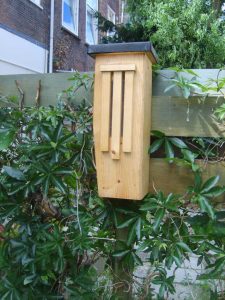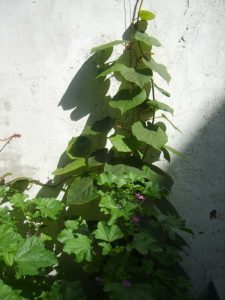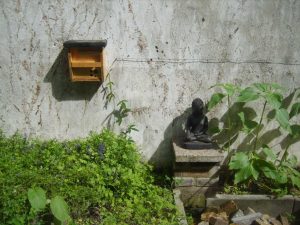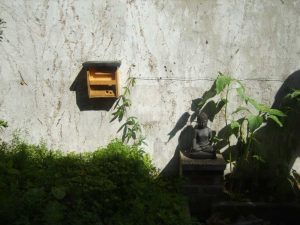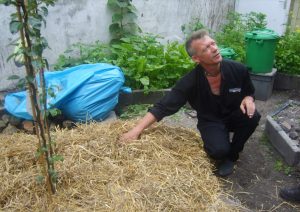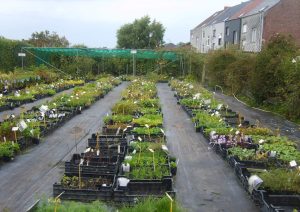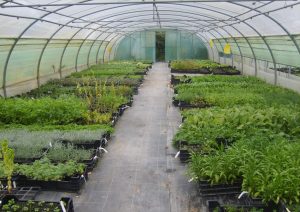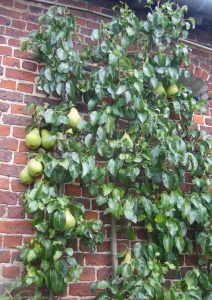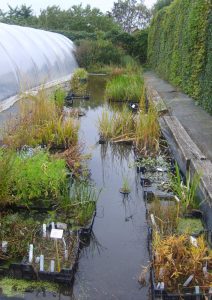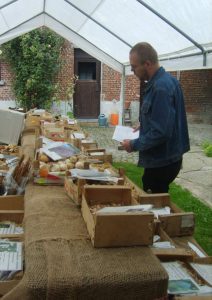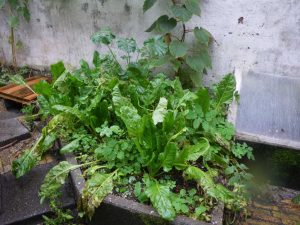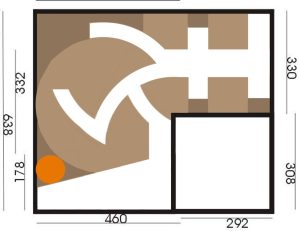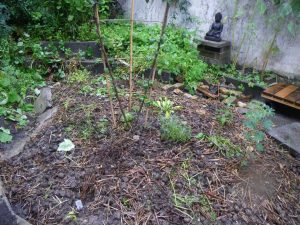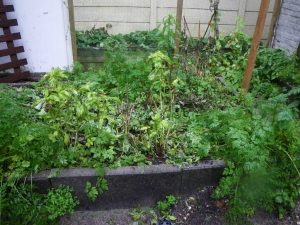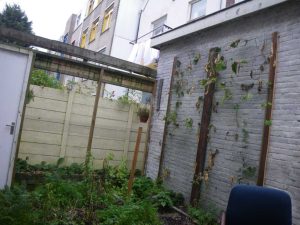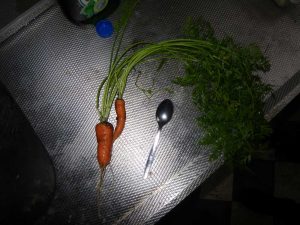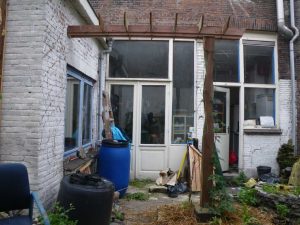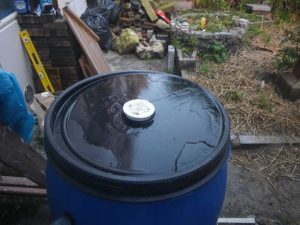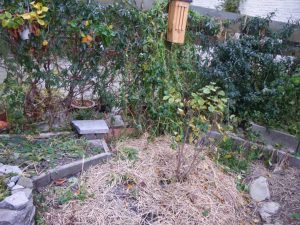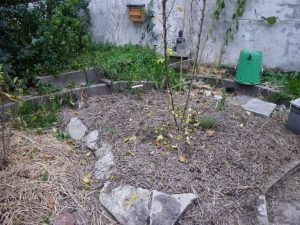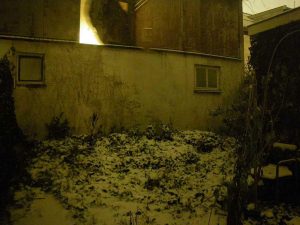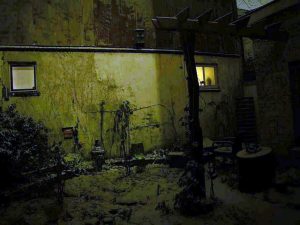During the year long Permaculture Design Certification Course we were asked to choose our own project so that we could put the theories into practice and possible also try out some of our own ideas. Due to the presence of an overgrown and neglected garden behind Sjef’s house at the time, we decided to sink our teeth in and to transform it, to an edible garden. At first we were under the assumption that we might possibly only be able to do soil purification, because of intense contamination by previously stored car engines by previous tenants. Gradually, we learned that the pollution seemed to have disappeared (It was 15 years ago after all, and thus possibly all had washed/seeped etc.) and then pretty soon changed our plans to creating an edible garden, where both theory and given examples, and lots of fun and fantasy all have been given a chance to come to expression. Since starting that change has become clearly visible, for both ourselves and the neighborhood and neighbors. And then also for the many birds that have gained both with the immediate neighbors as well as with us a nutrient rich and quiet/secluded space 😉
But first some introductions:

Sjef: Somewhere late 2006 Ray told me about Human Design, which brought me to the Gene Keys several years later. There I found the Anastasia Ringing Cedar book series by Vladimir Megre. Intrigued by the attention to nature and the people within it, I did a lookup online and quickly found Transition Towns, and then also Permaculture. After some more online digging it seemed Permaculture was the thing I unconsciously had been looking for, for the last 25 years. Not long after I landed on the website of ‘Gezonde Gronden‘ and their PDC year training. The appeal on the one hand is to be able to grow our own food and bring back the experience of our connection with the Earth and nature, as well as living more independent of forces and powers beyond our scope and also more self-determination and control over our own lives, food and the future. Furthermore taking into account the notion we may have had access to a lot less oil and other fuels for quite a while now already and the grotesque consequences of our dependence on them.
I experience Transition Towns and Permaculture as very important for the Earth and humanity, where Human Design and Gene Keys are much more important as an individual personal experience and endeavour.

Ray: I met Sjef late 2006 during a training program on starting your own business. At the time I coached people successfully for 5 years (through donations) on the relationship between nutrition & health en started my own business in 2007. In 2009 I did a free presentation in the Rudolf Steiner clinic at their winter-fair where I met Mireille and Borg, whom had already done this PDC training. After speaking with them I started reading up on Permaculture. Then I also read book 1 from Vladimir Megre’s Anastasia book series and became even more exited about Permaculture. Some 20 years ago I had 4 years of kibbutz experience, meaning: working on the land with fresh produce from your own soil which appealed to me at the time already. I see many advantages with Permaculture such as: self-reliance, sense of freedom, local food, less nutrition loss than found at retail and so with Permaculture healthier and cheaper food for less money and less strain on our environment.
I enjoy meeting like-minded people with passion, love and attention to health and nature, and to cooperate with it. In addition, I enjoy to contribute to the future of the world by reducing our footprint. Less fossil fuel, more freedom and being self-supporting really appeals to me. I see plenty of opportunities business-wise and it would seem a joy to eventually eat mainly, or even completely, foods from our own gardens and no more waiting in line at the health food store or other retailers or less at east.
So here is our 10 month report of were we came together twice nearly every week and (Ray) made copious notes:
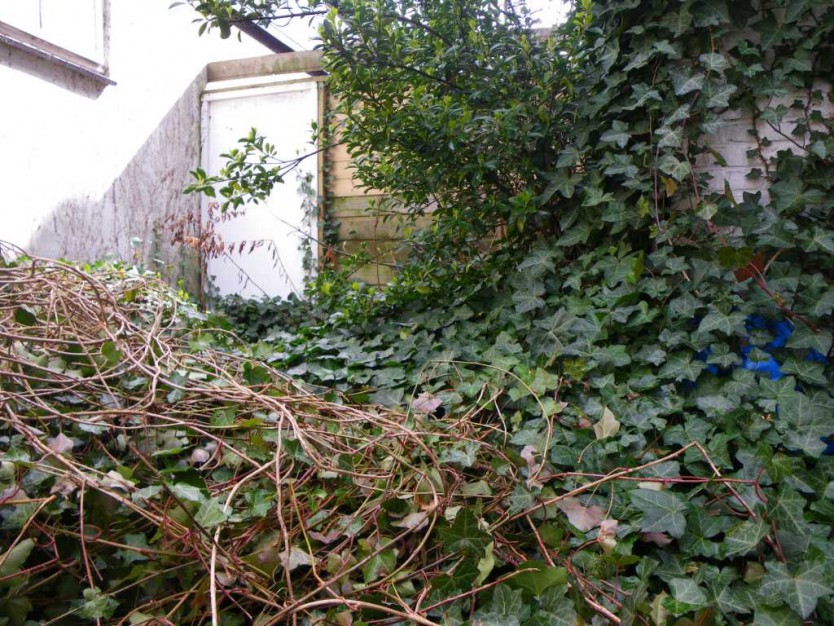
April 2010
In April we started out by measuring out the garden itself. We determined the direction of the sun, winds, rain and other external factors. Which later on gave a few surprises since they change with the seasons. About a week later we came together with 3 more people and took down the giant Ivy, which had taken over much of the garden in the last decade, and put it in bin-bags.
We discovered lots and lots of bricks and even household garbage inside and underneath the Ivy. Everyone shared their ideas and wishes on what such a garden might look like.
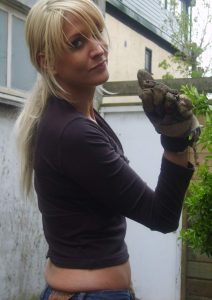
Princess and the Frog 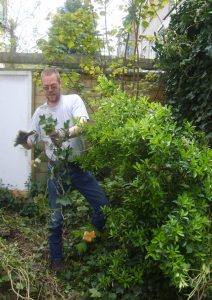
Clearing the Ivy
Many variants of plants, fruits and other stuff was shared about. We made observations on what is currently there and what we ourselves thought of. Regularly we made either close-ups or panorama shots as we also did now of the cleaned and cleared out garden. First we spoke of Zone 5 to include the 2 Japanese Spindle-wood bushes already present that we found at different spots as we took out the Ivy. We started collecting our fruit and veggie waste while still contemplating the different composting options. After all the clean-up we took a couple of soil samples to bring along to the next PDC class to analyze while also taking pictures of the sediment.
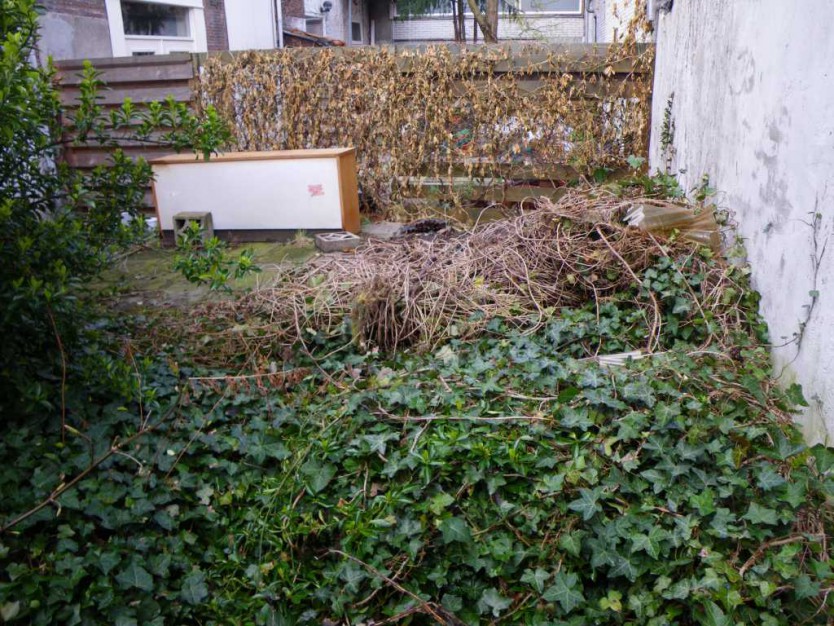
May 2010
After our documentation of the soil quality our 2nd observation focused on plant growth, the house and other influences like other animals and insects nearby, people, personal interests, time. While also considering the neighbors influence with their many potted plants and several birdhouses and bird-feeding trays. The wooden fence created a soggy shaded patch, so we replaced most of the planks for chicken-wire to bring in more sunlight and as it turned out also more winds.

With the 11 planks from the fencing a Trellis was to be constructed (for layer 3 climbers). As our knowledge grew and we gained a better perspective we decided to change the location and size of Zone5, so it could have one of the better spots in the garden, while also being least accessible to humans. My upstairs neighbor Ruud got exited too and started making some design suggestion as well. More people helped clean out the garden further and each brought their thoughts and ideas into the mix. Resulting in a toad hotel, a ladybug pension, butterfly and ear-worm residence, most of which were constructed by our upstairs neighbor from different re-used materials. However still lacking a Sarsaparilla plant, there was no sight of any Smurfs just yet.

After digging out the oak tree trunk we discovered an overturned wall, we collected and stacked the stones for later use. Construction of the Northern Zone5 began which became terraced. One side of the brick wall extension/room was completely cleaned of any trace of Ivy with a steel-brush by hand by Ray and then painted glossy white for more light reflection in the garden. Then Sjef added some chicken-wire to the freshly painted wall so the pole beans and other layer 3 climbers have something to grown into and through. Then a start was made at tiling the footpath and creating the big square-foot gardening rectangle, which the neighbor really put a few afternoons of effort in by reusing the big former terrace tiles by placing them upright into the ground.
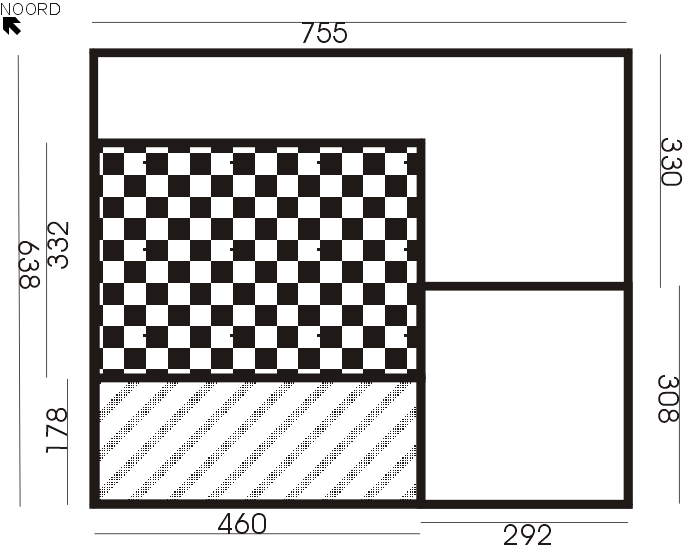
June 2010
This month we finished outlining all different zones and patches. The patch next to the brick wall extension with the chicken-wire got its pole bean seeds (Helda Phaseolus vulgaris) and Satureja hortensis (Summer savory). Right next to the Northern Zone5 a small patch of Salvia horminum (Sage), Origanum vulgare (Oregano), thimus vulgaris (thyme), Hyssopus officinalis, Melissa officinalis (lemon balm), Fragaria vesca (forest strawberry), ruta graviolens (Rue), Trifolium repens (clover), Cymbalaria muralis (Kenilworth Ivy), Erodium cicutarium (common stork’s-bill) and 2 kinds of Nasturtium were planted & seeded.
All patches (except the Guilds) received cold EM (Effective Microorganism), cold since we had not read the manual… We scooped out about 75% of the the top layer of sand from underneath the old Terrace to clear the way for the biggest of the 2 Guilds we thus far planned in the garden. Also some kiwi (Actinidia chinensis) and hung/potted strawberry was brought in. We bought some Bokashi starter en 2 taps for the composting bins, since we decided to go the Bokashi Composting way. All compost we gathered so far we spread out over the the 2 smaller Guilds.
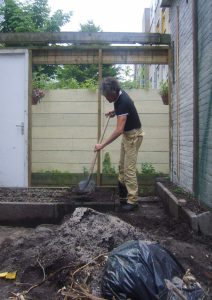
Preparing the SquareFoot Patch 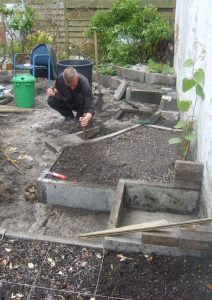
Outlining the foot path
We made up our minds about making the one big patch into 3 smaller/mini-guilds: the 2 pear Guilds and the Trellis/Rubus Guild, making the garden into Zones 1, 2 and 5. We planted some tomatoes and trimmed the strawberry. To protect against rot we put the Trellis foot/poles in cement. The Rubus for in the Trellis is waiting to be planted over. We made some EM correctly this time with the EM-Activator and after having learned about the value of water we got two 200 liter barrels + taps and drain-pipe fillers. We applied the latest batch of Bokashi compost into the soil near the Trellis and around the 2 pear-Guilds. For harvesting rain water we wiped the roof of the extension clean. Then sowed in 6 sun-flower seeds we got send from Arizona, some apricot and marigolds in the new small greenhouse and then transplanted 5 of the sunflowers to the Buddha/Bumble-bee house.
Also made a grid of string in the square-foot patch while Ruud intensively got rid of the black nightshade 😉 We got some Lycium barbarum (Goji berry), schisandra chinensis (a red berry), Lonicera caerulea edulis (blue-berried honeysuckle), Lonicera kamtschatica (another blue-berried honeysuckle) and Pyrus communis conference/bonne Louise (double pear tree) from fruitbomen.net in Boskoop. The Doyenne du Comice pear for the other Guild was currently out of stock.
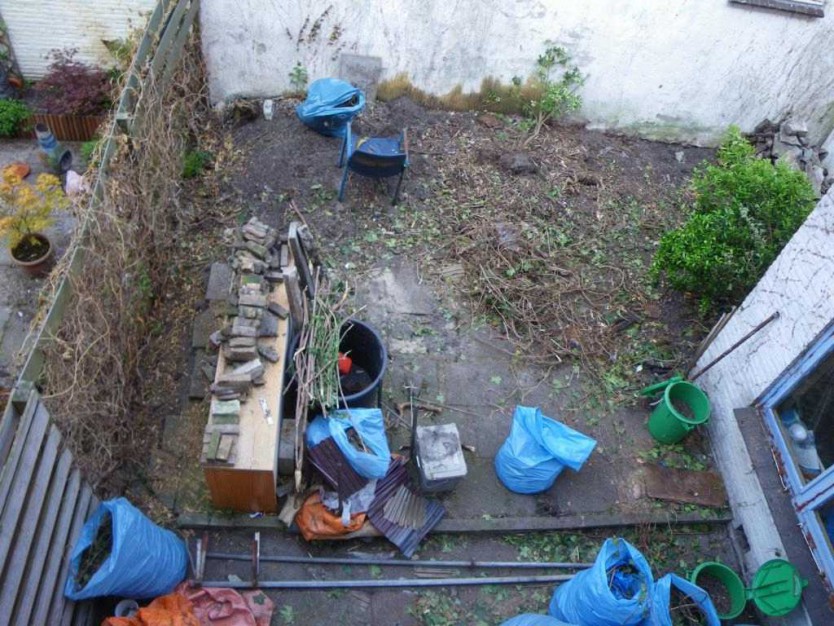
Photos
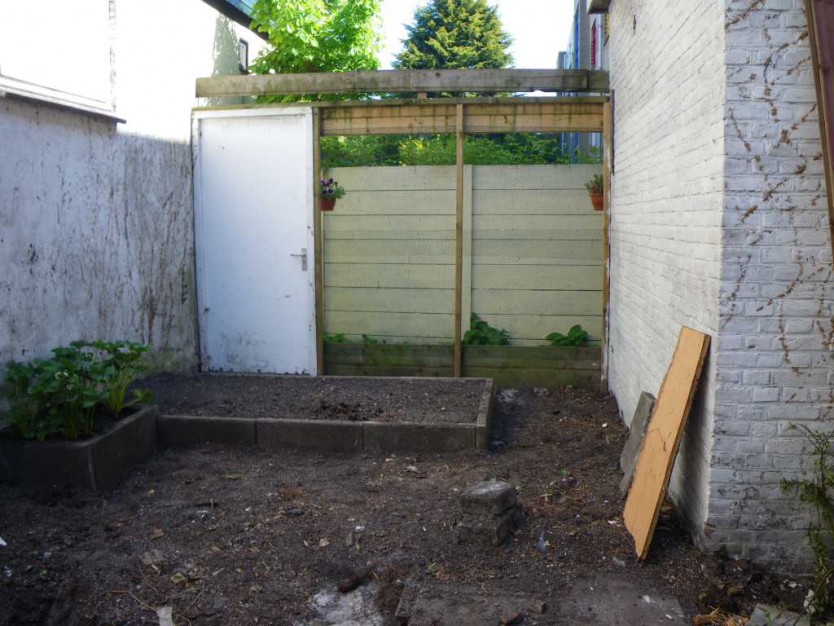
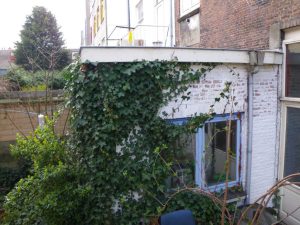
Ivy covered extension 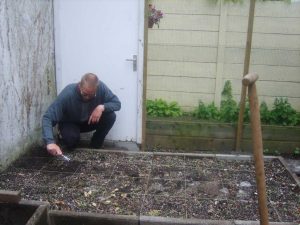
Square Foot Patch frolicking 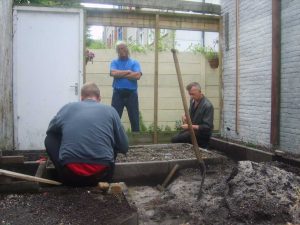
Everybody needs good neighbours 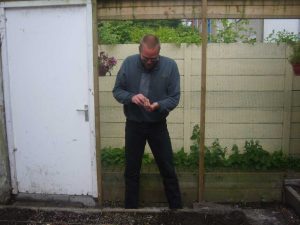
Seeding the SquareFoot Patch 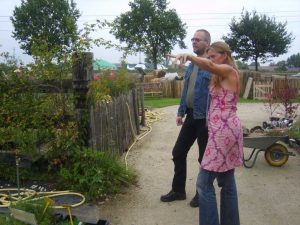
those you can find over there 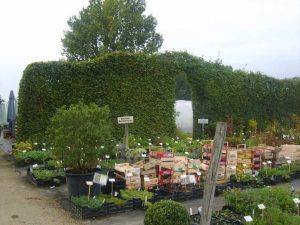
EcoFlora visit 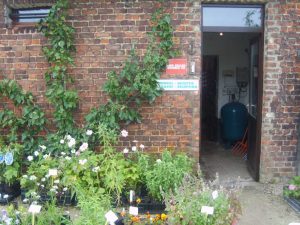
EcoFlora visit 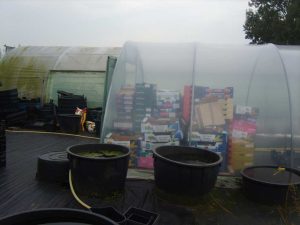
EcoFlora visit 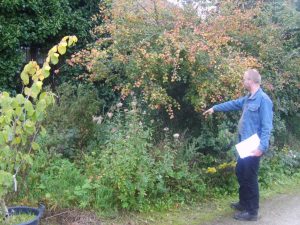
look, there is another something 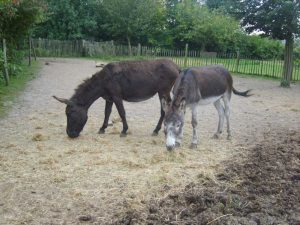
and Donkeys 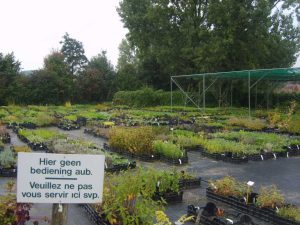
EcoFlora visit 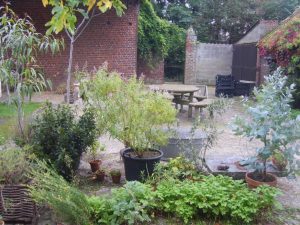
EcoFlora visit 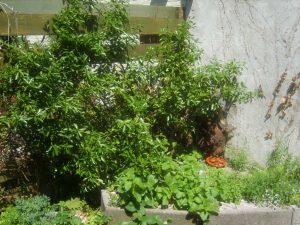
Japanese Spindlewood and Strawberry 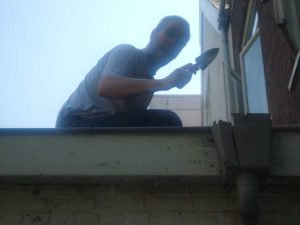
Sjef cleaning the Extension roof 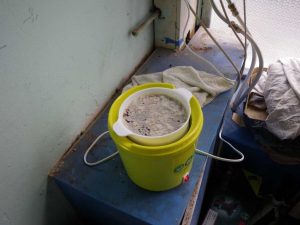
EM (Effective Microorganism) 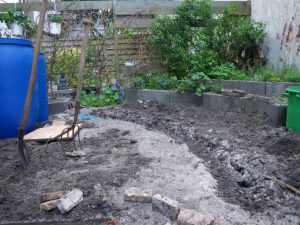
a trench for adding compost into 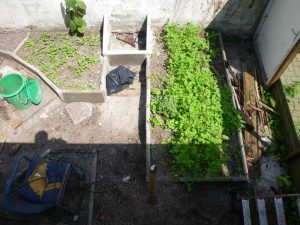
view from the Extension roof 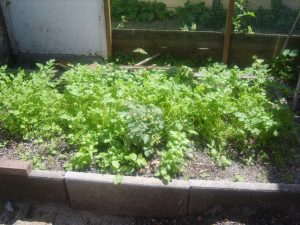
SquareFoot patch 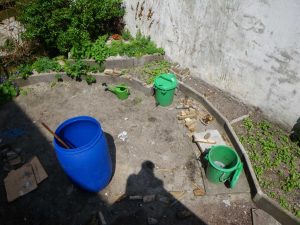
constructions unfolding 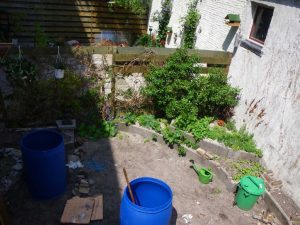
constructions unfolding
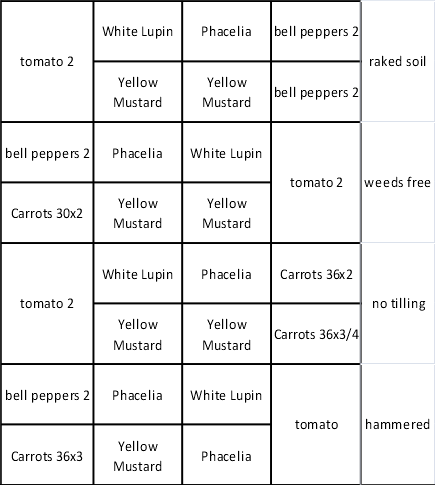
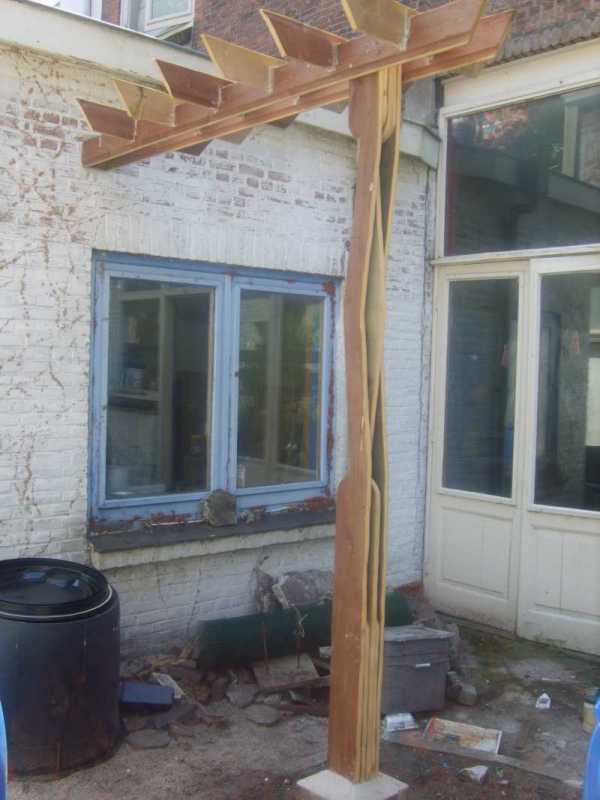
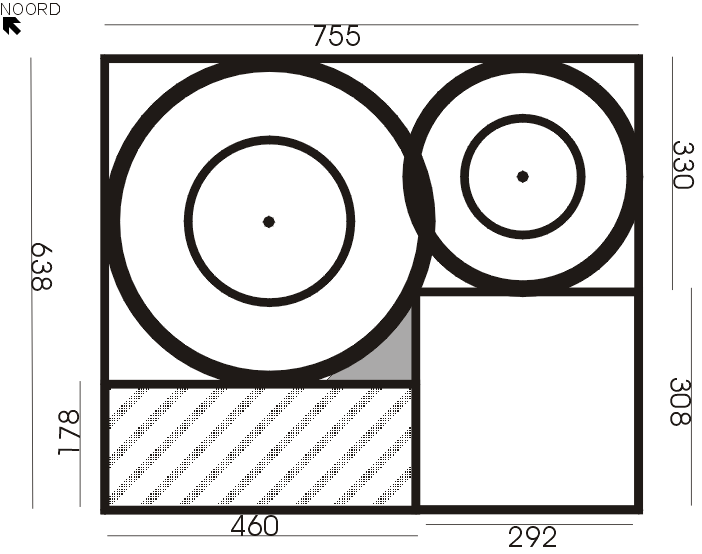
August 2010
This month the first thing we did was enlarge the Pear Guild since after some study and contemplation it turned out quite small in our slowly developing garden. Thus making the Rubus Guild smaller and dug in some eco-soil with added Bokashi (as experiment). In the Pear Guild we put one layer of cardboard, then one half a bale of straw en loads of fresh horse manure, from down the street, and seeded some Lupine on top of all that.
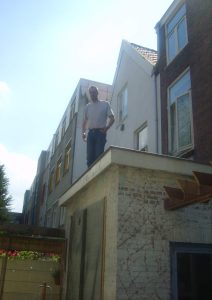
clearing the extension roof 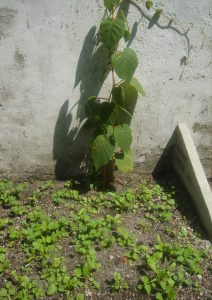
Kiwi and Green Manure
At the Rubus Guild: Borago officinalis, Galium odoratum (Woodruff), Allium tuberosum (chives), Rumex Sanguineus (Bloody Dock) and Marigolds were planted to support the Rubus. Along the edge of the Pear Guild we seeded some Dandelion (to avoid possible mold/fungi), and in the Guild itself were planted some Lavender and Ruta Graviolens (Rue) right into the layer of mulch against the Ants that were using the Pear-bushes to build a colony of Aphids.
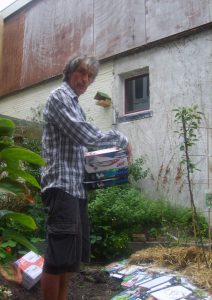
Ray handing out boxes 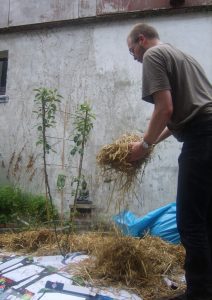
Sjef spreading out some straw
The tapped fluids from the compost were diluted and used to water the Pear-guild, the Rubus, The Schisandra and the Goji plants with. Ten seeds of Sage put into the greenhouse to protect against the Ants. In the Squarefoot area we made space for the Tomato, Bell Peppers and Carrots by taking out the Green Manure plants. We left some of the plants roots to see if they’d regrow later on. The rest of the plants used as mulch right there. We put some sticks and wires up with the Tomato and Bell-Pepper plants for support: Ray beheads one gorgeous baby Bell-Pepper plant doing this (aaaah). Also put sticks up for the SunFlowers.
Marigolds are in bloom, so is the Yellow Mustard. Put up 3 lengths of wire from the Kiwi along the wall in the direction of Zone5 so it can climb/grow sideways. Sjef kitted down the lids of the Composting bins making them air tight since both we as our neighbours were bugged by a lots and lots of little (fruit?)flies, too much !
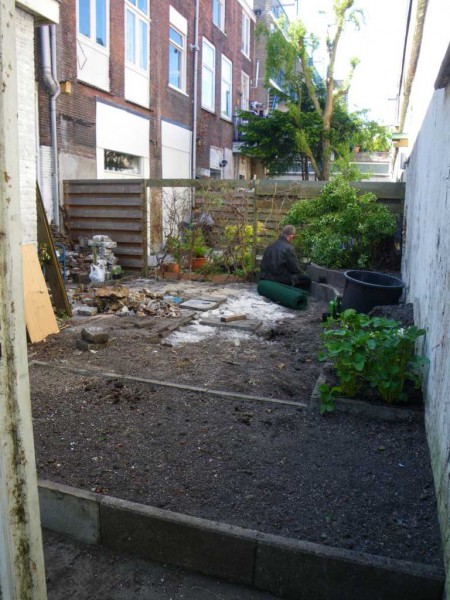
September 2010
During our first September gardening session we did another observation exercise. Sjef got a Hazel(nut) bush (Corylus Avellana) for his birthday from his sister and since the Doyenne du Comice Pear was sold out at the time, we decided to put the Hazel in that spot. All the weeds that grew in that spot were made into mulch around it. The trimmings of weakly bought whole pine-apples were sliced to bits in the Magimix to see if they’d break down faster in the compost. The Basil we harvested from the Squarefoot was put in Ray’s dehydrator and then Sjef made some Chicken dinner with it 🙂 Then another observation exercise of the garden before determining which and how much herbs and leafy veggies and so on we would buy on our trip to Eco-Flora in Belgium the next day.
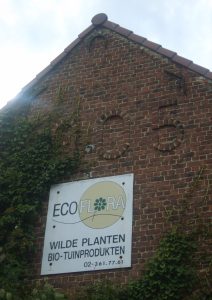
EcoFlora visit 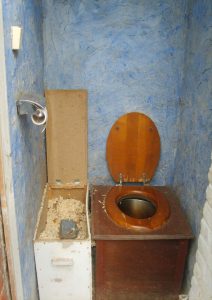
an EcoFlora toilet
The goal being: more leafy vegetables, herbs, green manures and already prepping the garden for wintertime, while also thinking ahead and buying seeds for next spring. We removed some more weeds and used them as more mulch around the Hazel. Watered the garden carefully at the roots with the sun so high in the sky as not to burn the leaves of, as the water becomes like a lens, with free collected rain water from the barrel with some tapped off compost fluids mixed in. And then off to Belgium to Eco Flora for the seeds, bulbs and herbs. We were inspired by the Minimalist Garden list seen in The Earth Care Manual by Patrick Whitefield for year round veggies, Sjef added the Dutch translation:
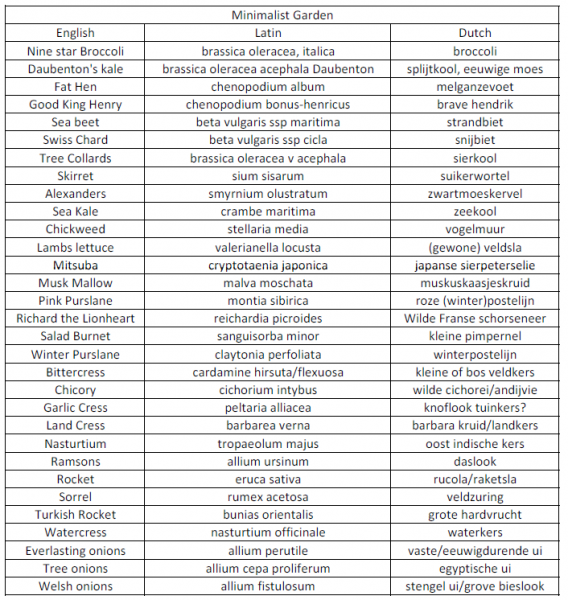
In the last week of September we planted: 2 Ramsons (allium ursinum) near the Rubus/Schisandra, 2 in the PearGuild, 2 near the Hazel, 2 with the Kiwi and his friends, 1 Jerusalem artichoke (Helianthus tuberosus) near the Runner Beans in the center, 1 with the SunFlowers, 2 with the Oak Tree stump right next to the Toad-Hotel, planted 2 more Goji-Berry (Lycium barbarum) in the Squarefoot Area with the other one and one Moroccan Mint plant inside a pot with no bottom so it wont grow too excessively, near the Schisandra Chinensis.
Planted 1 Skirret (sium sisarum) and 1 Wild Chicory (Cichorium intybus) and 1 Stevia with the Pear, 1 Salad Burnet (sanguisorba minor) 1 Salvia officinalis ‘Tricolori’ with the Hazel and Everlasting onions (allium perutile) in the herb structure. Through all these we managed (with the exception of big trees) to get all layers in our garden. We strung the SunFlower to the wall for support, and mulched some weeds from the herb-pit onto the Squarefoot soil. And then added some watered down Compost fluids to all new seedlings.
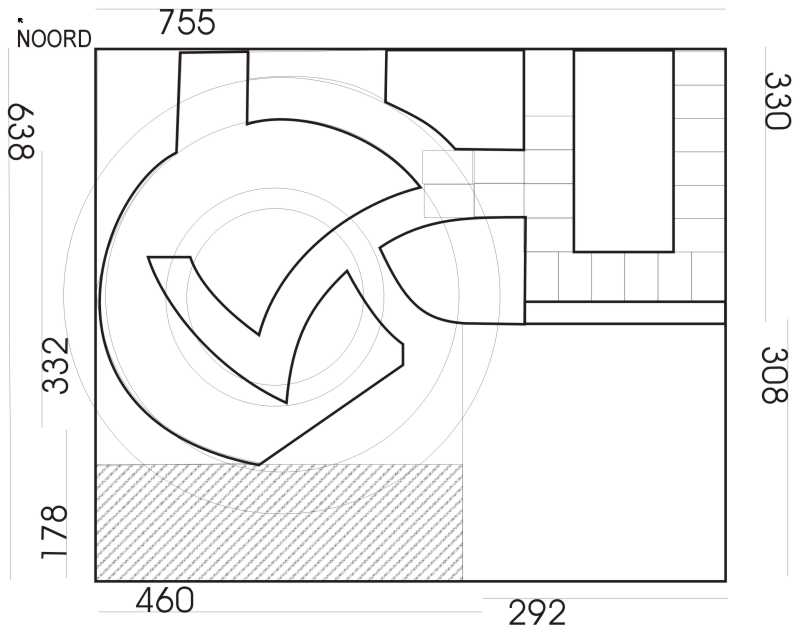
October 2010
After 2 weeks of fall weather we started out with another observation exercise. The crawling variant of the Nasturtium we harvested and used the remains as mulch, we left the climbing variant alone. Trimmed a bunch of weeds and also the overgrown Lemon Balm shrub. Tried to coppice the Lemon Balm and then piled everything up mixed with some Hay for mulching a bit later on.
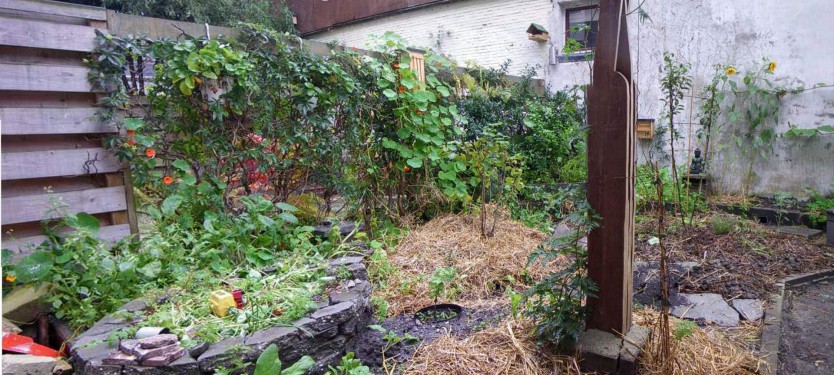
Mixed more compost fluids with our free rain water harvest and watered the garden. At the end of the month we did another observation and found 3 Tomato plants had died (1 was a bought plant and the others we seeded) We tried out some of our seeded winter carrot (yummy) and left the remainder in the soil for later. The Basil had grown too much but we’ll leave it be. The Gojis are growing alright and found the first thorn on it (ouch). All nightshade and part of the Lemon Balm was mulched in the Squarefoot. No mulch in the Runner Bean part, left it open as an experiment, just as we did with the Kiwi&Friends area, also because that has some Swiss Chard (beta vulgaris ssp cicla) to grow out which already covers much of the soil.
We left the PearGuild as it was, completely covered with the cardboard, straw and horse manure. We added some extra straw and mulch at the SunFlowers and mulched Nasturtium and straw around the Hazel. Lots of straw mulch at the bare Trellis/Rubus area and then some Nasturtium mulch in the herb-pit. Sjef added a bunch of White Clover (Trifolium repens) as Masanobu Fukuoka describes in his One-Straw Revolution book (wu wei wu) at the Nighshade/Squarefoot, PearGuild, Hazel, Trellis/Rubus and next to the SunFlowers at the one sitting area after taking away the wooden-seat of it as not to rot because of the coming winter. I’d like to add a link here to Ken Fern and his Plants For A Future efforts, his original book was another inspiration and the database and website are an invaluable resource. And then also eco-logicbooks and Permanent Publications
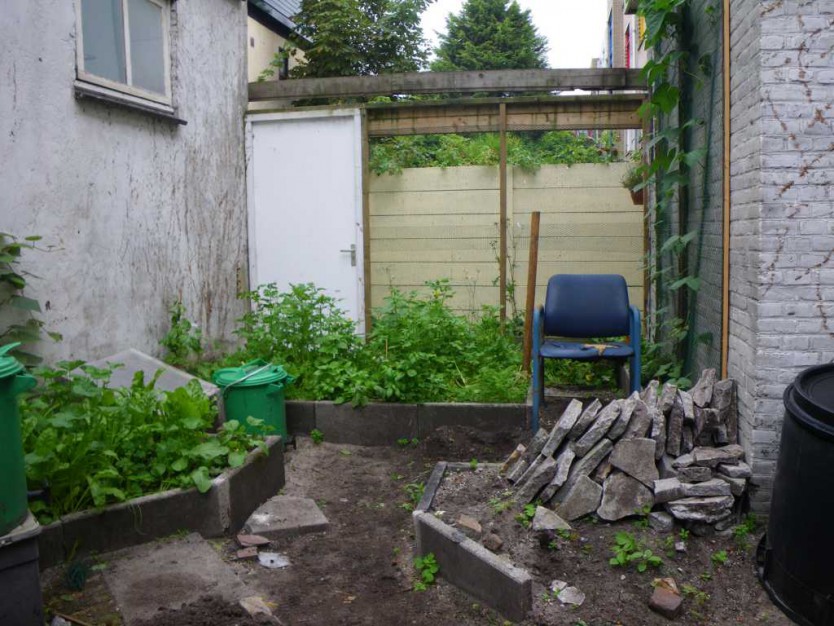
November 2010
Removed the Lemon Balm mulch from the SquareFoot since it started to take hold and grow out again. We determined it best for a next time to Bokashi the top-soil rigorously in the SquareFoot/Nightshade area. We took out the Wild Tobacco-plant, as it will spending the winter at Ray’s place indoors since it is so small and fragile still, which when we wrote this page a few weeks later is doing really well in the window there.


Left the Bean-patch as it was and made no other plants for it just yet. The plan for the Kiwi up next is to take out the weeds and mulch a combination of Bokashi, compost, straw and horse dung. At the PearGuild we had to re-apply the Manure since the birds throw it out with their beaks as they look for (we think) worms and seeds underneath. For the Rubus/Schisandra Guild we plan to add more mulch and compost since it had the least of the compost, EM or Bokashi and this part also has the least amount of sunlight. Left the Sunflower-patch as it was with no specific plans, same for the HazelGuild, while remaining somewhat blank about the herb-pit 😉 We used one of our gardening sessions for a homework assignment for class nr 9: assess the resistance and resilience of the garden and come up with some contingency plan which gave rise to much contemplation and seeing many loose or open ends.
Another time we emptied out the Compost completely and spread out over the SquareFoot and added another layer of soil. This compost seems to have failed probably because we did not add enough Bokashi. We noticed tiny little flies hovering over the Carrot plants, and only there. One of the planted Goji is growing quite wild and branches out so we want to guide it with some strings/wires. Due to hard rains and winds we want to poly-tunnel up the SquareFoot patch, and we added an old CD after microwaving it (to Craquelure it) to the PearBush as a scarecrow/deterrent for the pigeons and other stealing birds. Need to add some more of these as they harvest a lot quicker then we do.
Added a bunch of different Crocus bulbs in the Pear & Hazel Guilds hoping they’d come up first next spring. We plan to sow some winter veggies into and next to the herb-pit while revisiting the resistance and resilience of the garden by asserting the risks, which may not all be solved, but becoming aware has changed our perspectives. Made a seed-mixture of endives, winter radishes, early radishes, parsley, kale, broccoli, arugula, chives and paksoy, cleared out the patch around the Toad-hotel for mulching it, joined the seed-mixture with Bokashi and spread it out there too with more mulch and watered it with some more stored rain water. We observed that the thick layer of Cardboard/Straw and Manure is breaking down/dissolving into the soil.
The scare-crow CD tactics made by Sjef failed miserably, a new concept is being thought of. The Swiss Chard is thinning out, the Green manure plants are doing alright, the Kiwi and Goji are doing pretty well. However we seeded and planted the SunFlowers and several others a bit too late for them so they are not doing all too well, so following the sowing calender more strictly next time is needed.
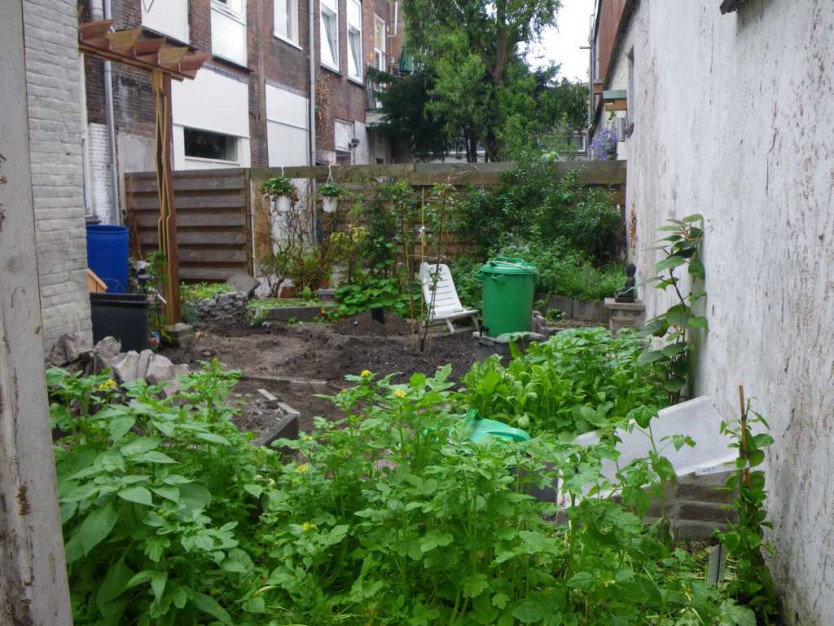
December 2010
Making an observation of a garden covered in snow 🙂
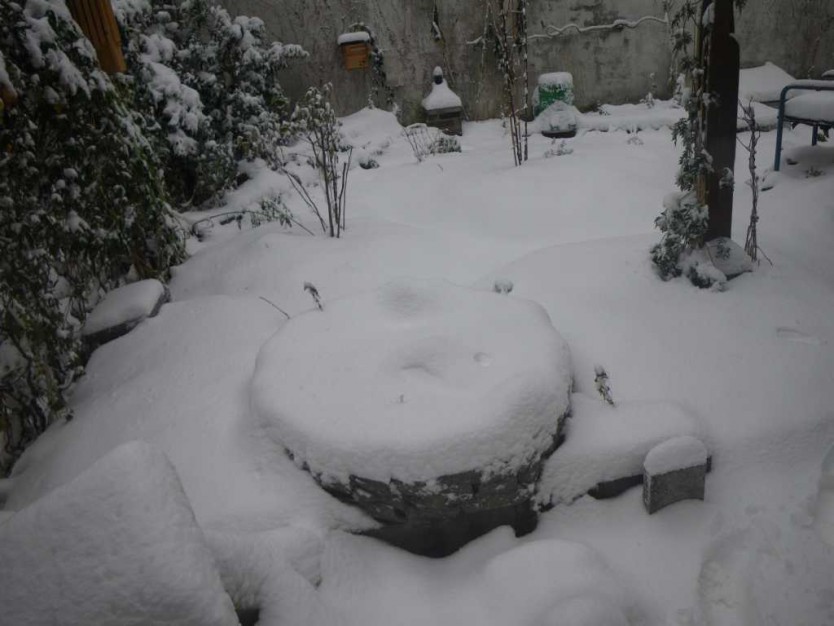
The Kiwi suddenly lost all of it’s leaves, the Nasturtium seems dead/frozen over. That’s all we could see.
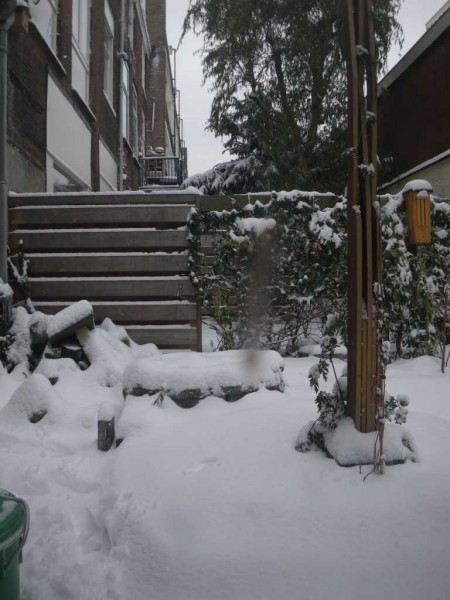
January 2011
What are the differences we noticed before applying Permaculture and after?
Less garbage/waist (compost)
Lower water bill (rain barrel)
Needing to buy less food (harvesting from own garden)
Happier (purpose and activity)
Sjef: yes, I changed plans/outlook for my own practical future. A renewed sense and depth of direction, a lower sense of victimization, a more leading/taking charge and less passive assertion. With only little information being able to make a huge turnaround.
Ray: I found even more appreciation and admiration for nature as I see a nice pear or andives at the eco/farmers market. I did also experience some frustration about current world affairs this past year. But due to this course I do feel less of a victim and much more able to take charge. In Socio/economics I can see more opportunities then before for improving the quality of health for all people and our society at large. I also have different ideas and plans for my own practical future.
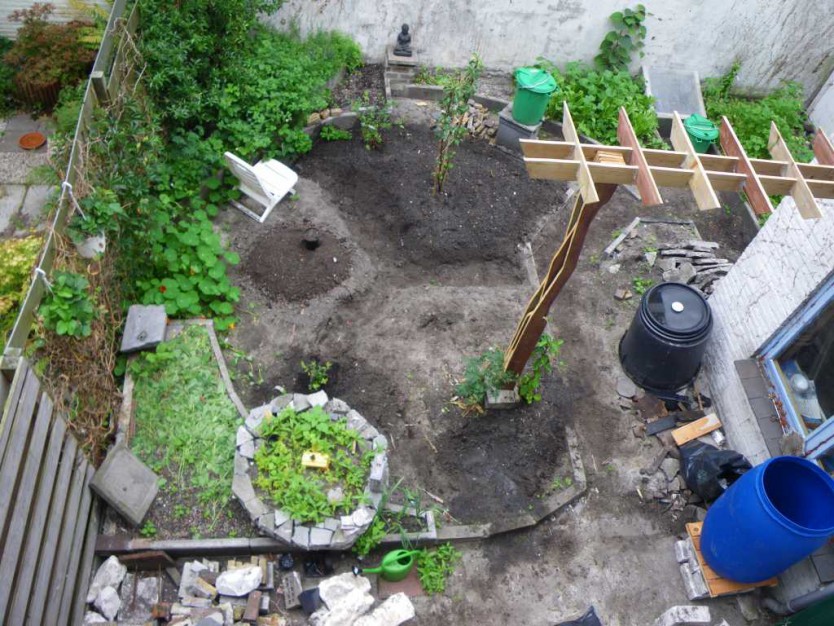
Permaculture Design Certificate: https://www.mcha.nl/2011/01/10/permaculture-design-certificate/
